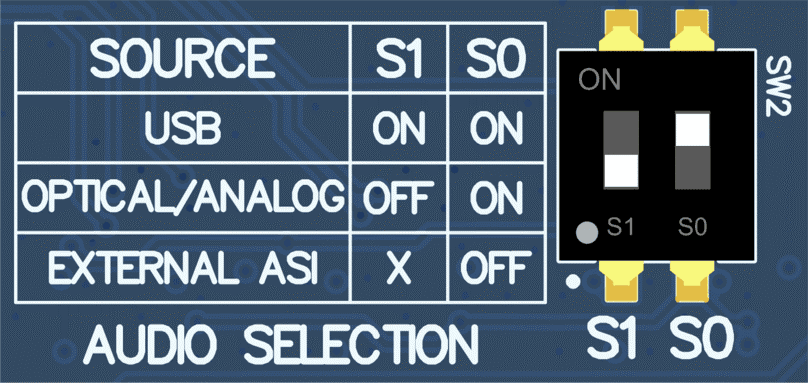SLAU903 October 2023
- 1
- Description
- Get Started
- Features
- Applications
- 6
- 1Evaluation Module Overview
- 2Hardware
-
3Software
- 3.1 Software Description
- 3.2 PurePath Console 3 Installation
- 3.3 TAx5x1x-Q1 EVM GUI
- 3.4 Configuration Examples
- 3.5 System Overview
- 4Hardware Design Files
- 5Additional Information
- 6References
2.2.1.2 Optical or Auxiliary Analog Audio Input Mode
Serial interface signals are provided from the PCM9211 digital transceiver, which is capable of sending digital data to the EVM from an analog input or optical input. Meanwhile, the data from the EVM can be streamed through the optical output.
Figure 3-4 shows the AC-MB audio setting for the optical and analog mode of operation.
 Figure 2-4 AC-MB Optical or Auxiliary Analog Audio Input Setting
Figure 2-4 AC-MB Optical or Auxiliary Analog Audio Input SettingThe optical output of the AC-MB streams the data captured on the EVM with the format determined by the input source used. When there is an optical input connected, the LOCK LED must be ON, and the PCM9211 streams the audio serial interface clocks with the format determined by the optical input frame. The digital data from the optical input is streamed to the evaluation module. If the optical input is not connected, then the PCM9211 captures the input signal provided through the analog input, and streams the signal to the evaluation module. This feature can be useful when a digital input digital-to-analog converter (DAC) is connected to the AC-MB, providing an analog input for quick evaluation. In auxiliary analog audio mode, the audio serial interface format is fixed to a 24-bit, 48-kHz, I2S mode.